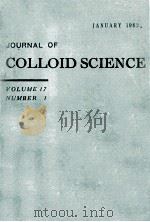《COLLOID SCIENCE VOLUME Ⅱ REVERSIBLE SYSTEMS》
| 作者 | H.R.KRUYT 编者 |
|---|---|
| 出版 | ELSEVIER PUBLISHING COMPANY |
| 参考页数 | 753 |
| 出版时间 | 没有确切时间的资料 目录预览 |
| ISBN号 | 无 — 求助条款 |
| PDF编号 | 811581798(仅供预览,未存储实际文件) |
| 求助格式 | 扫描PDF(若分多册发行,每次仅能受理1册) |
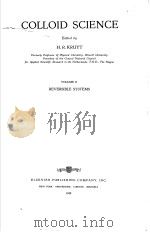
Ⅰ.A SURVEY OF THE STUDY OBJECTS IN THIS VOLUME&by H.G.Bungenberg de Jong1
1.DEFINITIONS1
a.The historical development of two lines of thought1
b.Definitions2
2.COMPARISON OF THE THREE TYPES OF SOLS3
a.Hydrophobic sols3
b.Sols of macromolecular colloids4
c.Sols of association colloids5
d.Recapitulation5
3.SURVEY OF COLLOID SYSTEMS IN VOLUME Ⅱ AND AIDS IN THEIR STUDY6
a.Preliminary remark6
b.Solutions proper6
c.Two phase systems6
d.Apparent single colloid systems7
e.Gels8
f.Recapitulation9
4.ON MENTAL ELIMINATION AS A METHOD OF CLASSIFICATION10
a.Ways of treating subjects in volume Ⅱ10
b.The elimination procedure,case of sols11
c.The elimination procedure applied to various colloid systems of macro-molecular colloids12
d.Recapitulation13
5.CLASSIFICATION OF SUBJECTS13
a.Choice of a main classification principle for colloid systems13
b.Macromolecular colloids14
c.Association colloids15
d.Static and dynamic colloid morphology17
Ⅱ.THE FORMATION AND STRUCTURE OF MACROMOLECULES&by R.Houwink19
1.THE EXISTENCE OF MACROMOLECULES AND THEIR BEARING ON COLLOID SCIENCE19
2.BONDS IN AND BETWEEN THE MACROMOLECULES21
3.THE FORM OF THE MACROMOLECULES22
4.THE DIMENSIONS OF MACROMOLECULES23
5.CHEMICAL CONSTITUTION26
A,B.Natural macromolecules and their derivatives26
1.Polysaccharides26
2.Proteins28
a.The main chain28
b.The side chains34
3.Rubber35
4.Drying oils36
5.Natural Resins36
C.Entirely synthetic macromolecules36
D.Inorganic macromolecules38
Linear polymers38
Two-dimensional polymers40
6.THE BUILDING UP OF MACROMOLECULES IN NATURE AND IN PRACTICE;GEL AND ISOGEL FORMATION40
A.Building up in practice40
a.Condensation reactions41
b.Polymerisation reactions42
1.The start reaction42
2.The chain growth42
3.The final reaction42
B.Building up in nature45
Ⅲ.THERMODYNAMICS OF LONG-CHAIN MOLECULES&by J.J.Hermans49
1.INTRODUCTION49
a.Comparison between macromolecules and micromolecules49
b.Scope of the present chapter49
2.THERMODYNAMIC FUNCTIONS.COEXISTING PHASES OF THE PURE SUBSTANCE50
a.Symbols used50
b.Thermodynamic functions with respect to degree of polymerisation51
c.The melting process;melting point and heat of melting52
c.1.Melting point52
c.2.Melting range53
d.Crystallization in macromolecular solids54
3.GENERAL PROPERTIES OF SOLUTIONS56
a.Partial molar quantities;free energy and heat of dilution(and solution)56
b.Determination of thermodynamic quantities in a mixture58
b.1.Vapour pressure58
b.2.Osmotic pressure59
4.SIMPLE MODEL OF POLYMER SOLUTIONS60
5.HEAT oF MIXING61
a.Derivation of formula62
b.Discussion63
c.Heat of dilution at low concentrations65
6.ENTROPY OF MIXTURES66
a.Entropy and probability66
b.Entropy of mixing in ideal solutions67
c.Equilibrium between polymer and ideal solution70
d.Entropy in non-ideal polymer solutions72
d.1.Introductory remarks72
d.2.Calculation of entropy72
d.3.Dilute solutions74
d.4.Extremely dilute solutions75
e.Thermodynamic behaviour of a polymer homologous mixture75
7.Free energy of polymer solutions76
a.Separation into two layers;solubility of high polymers77
a.1.Equilibrium between dilute and concentrated phase77
a.2.Solubility78
b.Fractional precipitation79
b.1.Addition of non-solvent79
b.2.Change of temperature80
c.Physical meaning of interaction constant γ81
8.OSMOTIC PRESSUPRE AND SWELLING PRESSURE83
a.Osmotic pressure in dilute solutions83
a.1.Kinetic theories83
a.2.Thermodynamic treatment84
b.Osmotic or swelling pressure in concentrated systems86
b.1.General considerations86
b.2.Cross-linked gels87
9.REVIEW OF THE THERMODYNAMICS OF POLYMER SOLUTIONS90
a.Limits of applicability90
b.Discussion of some experiments91
Ⅳ.THE PHYSICAL PROPERTIES OF RANDOMLY KINKED LONG CHAIN MOLECULES&by J.J.Hermans93
1.INTRODUCTION93
2.STATISTICAL TREATMENT.OPTICAL ANISOTNOPY OF THE MACROMOLECULE94
a.Introductory remarks95
b.Statistical considerations96
c.Final remarks99
3.DIPOLE MOMENT OF LONG-CHAIN MOLECULES100
4.SEDIMENTATION VELOCITY OF LONG-CHAIN COMPOUNDS102
5.TIME OF RELAXATION104
6.VISCOSITY106
a.Derivation of viscosity formula106
b.Interpretation of experimental data108
c.Validity of Staudinger's rule110
d.Non-Newtonian viscosity in dilute solution113
7.BIREFRINGENCE OF FLOW115
a.Outline of the theory115
b.Double refraction116
c.Extinction angle116
8.KRAMERS'METHOD.RAMIFIED MOLECULES AND RINGS117
9.CONCRNTRATED SOLUTIONS118
a.Viscosity at high concentrations118
b.Network in the solution119
c.Associative bonds119
d.Short-range order120
e.Time-effects120
f.Non-Newtonian viscosity in concentrated solutions121
g.Ultrasonics122
10.SOLID MATTER CONSISTING OF RANDOMLy KINKED MOLECULES123
a.Elasticity of the dry polymer substance123
b.Swelling of polymer networks127
c.Double refraction of stretched rubber128
Ⅴ.THE DETERMINATION OF THE MOLECULAR WEIGHT OF MACROMOLECULES&by J.J.Hermans and P.H.Hermans131
1.INTRODUCTION131
2.CHEMICAL METHODS133
3.OSMOTIC PRESSURE133
4.DIFFUSION136
5.ULTRACENTRIFUGE137
6.VISCOSITY140
7.BIREERINGENCE OF FLOW142
8.PRECIPITATION144
9.OPTICAL METHODS145
10.COMPARISON OF RESULTS OBTAINED WITH DIFFERENT METHODS149
Ⅵ.MACROMOLECULAR SOLS WITHOUT ELECTROLYTE CHARACTER&by R.Houwink153
1.DISSOLUTION AND SWELLING OF HIGH-POLYMERS153
a.General considerations153
b.Dissolution,considered from a thermodynamic stand-point154
1.The cohesion factor154
2.The entropy-factor155
c.Dissolution considered from a molecular stand-point156
2.THE INFLUENCE OF VARIOUS FACTORS ON THE SOLUBILITY158
a.The relation between the cohesion factor and the entropy factor158
b.The influence of temperature159
c.The influence of the polymerisation degree159
d.The influence of the chemical constitution161
e.The influence of interlinking164
f.The influence of crystallisation165
3.VISCOSITY IN DILUTE SOLUTIONS166
a.Theoretical basis166
b.Applications168
b.1.Molecular weight determinations168
b.2.Determination of the form of the molecules169
b.3.The chemical structure173
b.4.The presence of loose micelles174
b.5.The influence of polydispersity175
b.6.Thixotropy and Rheopexy175
4.VISCOSITY IN CONCENTRATED SOLUTIONS176
5.VISCOSITY OF ONE-COMPONENT SOLS180
a.Viscosity increase on polymerisation180
b.Temperature influence on viscosity181
Ⅶ.SOLS OF MACROMOLECULAR COLLOIDS WITH ELECTRO-LYTIC NATURE&by J.Th.G.Overbeek and H.G.Bungenberg de Jong184
1.INTRODUCTION AND SURVEY OF THE SUBSTANCES TO BE TREATED IN THIS AND IN THE FOLLOWING CHAPTERS184
a.The electric charge as special characteristic of a group of colloids184
b.Shape and size of the kinetic units185
c.Divisions of the colloids to be treated,according to the nature and sign of the charge of the ionogenic groups186
2.NATURE OF THE ELECTRIC CHARGE OF MACROMOLECULAR COLLOIDS188
a.Origin of the charge188
b.The influence of the pH and the composition of the solution on the charge of the macromolecule189
3.THE ELECTRIC CHARGE OF MACROMOLECULES AS DETERMINED BY ELECTROPHORESIS193
a.The interpretation of the electrophoresis of macromolecules193
b.Some examples195
4.FORMER CONCEPTIONS ON THE NATURE OF THE KINETIC UNITS IN HYDROPHILIC SOLS OF THE HIGH VISCOUS TYPE197
5.CHANGES IN(ηs—ηo)/ηo AT CONSTANT COLLOID CONCENTRATION,CAUSED BY ALTERING THE COMPOSITION OF THE SOLVENT199
A."Solvation"200
B."Electric Charge"(Electroviscous Effect)203
6.REINTERPRETATgON FROM THE MACROMOLECULAR POINT OF VIEW OF THE CHANGES OF(ηs—ηo)/ηo CAUSED BY ALTERING THE COMPOSITION OF THE SOLVENT(AT CONSTANT COLLOID CONCENTRATION)209
7.INFLUENCE OF TEMPERATURE ON(ηs—ηo)/ηO212
8.THE ELECTROVISCOUS EFFECT AS A DISTURBING FACTOR IN THE DETERMINATION OF THE LIMITING VALUE OF(ηs—ηo)/ηo C AT COLLOID CONCENTRATION ZERO.213
9.REVERSAL OF CHARGE AND ELECTROVlSCOUS EFFECT217
10.TRANSGRESSIONS OF SOLUBILITY ACCOMPANYING THE SUPPRESSION OF THE ELECTRO-VISCOUS EFFECT223
11.VISCOUS BEHAVIOUR OF SHORT CHAIN-MACROMOLECULAR"COLLOIDS"227
12.Low VISCOUS BEHAVIOUR AS A RESULT OF EXISTING"COMPLEX RELATIONS"228
Ⅷ.CRYSTALLISATION—COACERVATION—FLOCCULATION&by H.G.Bungenberg de Jong232
1.Low AND HIGH DISPERSED STATES OF THE COLLOID-RICH PHASE WHICH SEPARATES OUT232
a.Crystallisation and Coacervation232
b.Flocculations and formation of apparent single systems of composite nature233
c.The liquid type of the apparent single colloid systems and their relation to flocculation234
d.An example of the solid type of the apparent single colloid systems236
e.Recapitulation and further remarks237
2.THE UNIQUE POSITION OF THE CORPUSCULAR PROTEINS:CRYSTALLISATION AND DENATURATION239
3.COACERVATION AND COACPRVATES243
4.COACERVATION OF MACROMOLECULAR COLLOIDS OF THE HIGH VISCOUS TYPE PROM MODERN POINTS OF VIEW248
5.DIVISION OF COACERVATION INTO TWO MAIN TYPES250
6.SIMPLE COACERVATION OF ISOELECTRIC GELATIN WITH ALCOHOL OR Na2SO4251
7.SIMPLE COACERVATION OF ISOELECTRIC GELATIN WITH RESORCINOL253
8.SIMPLE COACERVATION IN MIXTURES OF CONCENTRATED GELATIN AND GUM ARABIC SOLS255
Ⅸ.REVERSAL OF CHARGE PHENOMENA,EQUIVALENT WEIGHT AND SPECIFIC PROPERTIES OF THE IONISED GROUPS&by H.G.Bungenberg de Jong259
1.RECIPROCAL HEXOL NUMBER AND EQUIVALENT WEIGHT;CHARACTERISTIC CHARGE ELEMENTS259
a.Introduction259
b.The reversal of charge of sodium arabinate and other colloids of acidic nature with hexol nitrate.Reciprocal hexol number and equivalent weight262
c.Origin of the negative charge of colloids of acidic nature and mechanism of the reversal of charge with hexol nitrate266
d.Equivalent weight and flocculability269
e.Indications of the occurence of a second characteristic charge element,determining specific behaviour of colloids271
f.Apparent equivalent weights273
g.Characteristic properties of the ionised groups causing specific behavinur of colloids274
2.SPECIFIC CATION SEQUENCES IN THE REVERSAL OF CHARGE OF COLLOIDS OF ACIDIC NATURE WITH INORGANIC CATIONS276
a.Introduction276
b.Complete colloid films at particle surfaces and their use in determining reversal of charge concentrations277
c.Phosphate colloids280
d.Carboxyl colloids284
e.Sulphate colloids285
f.The role of the polarisability of the ionised groups.Comparison of the cation spectra of phosphate and sulphate colloids287
g.Comparison of the cation spectra of phosphate and sulphate colloids continued.Influence of the ion radius.Abnormal sequences288
h.Comparison of the cation spectra of phosphate and sulphate colloids continued.Cations of the B subgroups compared with cations of the A subgroups290
i.Comparison of cation spectra of phosphate and sulphate colloids continued.Influence of the cation valency.The individual behaviour of complex ions,of Th and Al291
j.The cation spectra of carboxyl colloids291
k.Constitutional influences on the polarisability of the ionised group292
l.The absolute values of the reversal of charge concentrations294
m.Final remarks295
3.SPECIFIC ION SEQUENCES IN THE REVERSAL OF CHARGE OF PROTEINS297
a.Cation sequences in the reversal of charge of negative proteins297
b.Anion sequences in the reversal of charge of positive proteins299
4.REVERSAL OF CHARGE WITH ORGANIC IONS300
a.Introduction300
b.Reversal of charge sequences of substituted ammonium cations in sulphate,carboxyl,and phosphate colloids303
c.Reversal of charge sequences of organic anions in positive proteins306
d.Discussion309
5.REVERSAL OF CHARGE WITH SALT MIXTURES311
a.Introduction.Additivity and antagonism311
b.Importance of the quotient of the reversal of charge concentrations of both members in a salt combination312
c.The role of anions in the so-called cation antagonism316
d.The general form of antagonism curves and the role of Q in determining the intensity of deviations from additivity318
e.Reversal of charge in mixture of three salts320
f.Reversal of charge in mixtures of salts containing organic cations320
6.REVERSAL OF CHARGE PHENOMENA IN MIXTURES OF COLLOIDS321
a.Reversal of charge at constant pH on varying the mixing ratio of oppositely charged colloids321
b.Reversal of charge at constant mixing ratio on varying pH322
c.The reversal of charge in a mixture of oppositely charged colloids as a function of the colloid concentrations326
d.The reversal of charge in mixtures of three colloids328
e.Retrograde reversal of charge phenomena330
Ⅹ.COMPLEX COLLOID SYSTEMS&by H.G.Bungenberg de Jong335
1.INTRODUCTION335
a.Division into three principal types335
b.Variants of the principal types336
c.Order of the subject matter in relation to the role of the characteristic charge elements337
2.DICOMPLEX SYSTEMS Ⅰ.VARIANT COLLOID CATION+COLLOID ANION338
a.Introduction338
b.Complex coacervation in the narrower sence338
c.Reversibility of complex coacervation339
d.Role of pH and mixing proportion in complex coacervation340
e.Behaviour of complex coacervate drops in an electric field345
f.Salt influences on complex coacervation349
g.Composition of coacervate and equilibrium liquid in an isohydric series of mixtures(schematic)355
h.Composition of coacervate and equilibrium liquid at the equivalent mixing proportion357
i.Position of the"demixing"figure at various pH's359
j.Distribution of the colloid component present in excess in an isohydric series of mixtures over coacervate and equilibrium liquid360
k.Changes of composition of coacervate and equilibrium liquid at constant mixing proportion and variation of the pH362
l.Influence of an added salt on the composition of coacervate and equilibrium liquid364
m.Influence on the colloid concentration of the isohydric sols366
n.The water content of the complex coacervates368
o.Theory regarding the internal state of the complex coacervate370
p.Complex flocculation372
q.Systems of higher order,preceding complex flocculation or complex coacervation373
r.Significance of the equivalent weight of the complex components374
s.Specific ion sequences in suppression by indifferent salts376
t.Complex coacervation in the presence of three colloid components378
u.Complex gels381
3.DICOMPLEX SYSTEMS Ⅱ.THE VARIANTS COLLOID CATION+MICRO ANION AND MICRO CATION+COLLOID ANION384
a.The coacervation of gum arabic with hexol nitrate as an example of the variant micro cation+colloid anion384
b.The coacervation of positive ichthyocoll sol with K3Fe(CN)6 as an example of the variant colloid cation+micro anion389
c.Anomalies in the double valency rule and their significance391
d.Further examples of dicomplex coacervation or flocculation,colloid ion+oppositely charged micro ion.R?le of the ion valency and of the colloid equivalent weight392
e.Specific factors in the dicomplex coacervation or flocculation,colloid ion+oppositely charged micro ion.Equivalent flocculation394
f.Dicomplex coacervation or flocculation supported by alcohol or acetone396
g.Mutual comparison of the inorganic cations as regards the dicomplex coacer-vation or flocculation of gum arabic400
h.Significance of the"reversal of charge spectra"404
i.Dicomplex coacervation of phosphatides with cations405
j.Dicomplex coacervation colloid ion+micro ion reduced to its simplest form406
4.DICOMPLEX SYSTEMS Ⅲ.THE VARIANT MICRO ANION+MICRO CATION IN CON-NECTION WITH THE THEORY OF COMPLEX COACERVATION407
a."Demixing"in mixtures of aqueous salt solutions407
b.Stable and metastable unmixing in binary systems salt+water409
c.The essence of complex relations412
5.UNICOMPLEX SYSTEMS413
a.Unicomplex sols413
b.Unicomplex flocculation414
6.TRICOMPLEX SYSTEMS415
a.Tricomplex flocculation.Working hypothesis415
b.General condition for the production of tricomplex systems418
c.Significance of the colloid equivalent weight and of the composition of the ionised group of the colloid anion419
d.Specific ion sequences in the production of tricomplex flocculation,variant colloid amphoion+micro cation+micro anion421
e.Specific cation sequence in the production of tricomplex flocculation,variant:colloid amphoion+micro cation+colloid anion425
f.Specific ion sequences in the suppression of tricomplex flocculations429
Ⅺ.MORPHOLOGY OF COACERVATES&by H.G.Bungenberg de Jong433
1.STATIC COLLOID MORPHOLOGY433
a.Introduction433
b.Interracial tension coacervate/equitibrium liquid433
c.Wetting phenomena435
d.Horizontal observation436
e.Gelatin gel bodies with enclosed gum arabic vacuole437
f.The morphology of compound coacervate drops438
g.Vacuoles in three-phase contact439
h.Significance of the colloid equivalent weight for the morphology of composite coacervate drops440
2.NON-COMPLICATED VACUOLATION443
a.Place,number and size of the vacuoles formed443
b.Behaviour of vacuoles compared with that of inclusions445
c.Vacuolation phenomena in oleate coacervates by volatile and non-volatile organic non-electrolytes446
d.Vacuolation in the gelation of coacervate drops447
3.MOTORY PHENOMENA451
a.Motory phenomena in a diffusion field451
b.Motory phenomena in coacervatcs of the dicomplcx type in a d.c.electric field452
4.ABNORMAL VACUOLATION454
a.Pulsating vacuoles454
b.Formation of relatively thick-walled hollow spheres in complex coacervates containing nucleic acid455
c.Formation of foam structures and hollow spheres in the gum arabic-gelatin complex coacervate459
d.Properties of the hollow spheres and of the massive coacervate drops which are produced from them by degeneration463
e.Gelatinized hollow spheres.Invagination processes464
f.Colloid displacements in gelatinized hollow spheres towards the vacuole.465
5.COLLOID SYSTEMS SURROUNDED BY TOTALLY CLOSED MEMBRANES467
a.Morphology after coacervation of the enclosed colloidal system467
b.Dynamic colloid morphology of the parietal gelatin+gum arabic complex coacervate enclosed in the cell compartments472
c.Reversible colloid displacements between gelatinized parietal complex coacervate and central vacuole.Accumulation of neutral red474
d.Changes in the wetting of the cell membranes475
6.COLLOID MORPHOLOGY OF PHOSPHATIDE COACERVATES477
a.Multiple coacervate drops in phosphatides477
b.Behaviour of phosphatide coacervate drops in a d.c.field479
c.The anomalous behaviour of the vacuoles in phosphatide coacervates480
Ⅻ.GELS&by P.H.Hermans483
1.INTRODUCTION.DEFINITION OF THE GEL STATE483
2.SOME BRIEF HISTORICAL NOTES IN CONNECTION WITH TERMINOLOGY485
3.THE FORMATION AND STRUCTURE OF GELS488
a.General condition of gel formation488
b.Gelformation and demixture490
c.Gel formation from crystallisable low molecular substances491
d.Gel formation from solutions of macromolecular substances494
4.GENERAL PHYSICAL PHENOMENA OF THE SOL-GEL TRANSFORMATION499
a.Transition temperature499
b.Thermal effects500
c.Optical effects500
d.X-ray examination501
e.Volume changes503
f.Flow properties504
g.Electrical conductivity and diffusion508
5.MECHANICAL EFFECTS ON THE SOL-GEL TRANSFORMATION509
a.Mechanical disturbance of gel formation509
b.Thixotropy510
6.SORPTION AND SWELLING512
a.Sorption512
1.Some general remarks on the nature of sorption512
2.Some basic theoretical principles513
α.Molecular interaction and deviation from Raoult's equation514
β.The Langmuir isotherm515
γ.Complication factors and some further considerations519
δ.Capillary condensation522
ε.The Freundlich isotherm524
3.Some particular instances of sorption524
α.Amorphous carbon525
β.Silica gel529
γ.Cellulose536
δ.Nitrocellulose548
ε.Some further remarks on swelling systems in general555
b.Swelling556
1.Swelling pressure557
2.The degree of swelling557
α.Systems without electrolyte character557
β.Systems with electrolyte character560
3.Some recent aspects of the mechanism of swelling567
4.Syneresis573
5.Hysteresis phenomena in the preparation of xerogels573
6.Volume contractions in swelling systems574
7.Swelling and optical properties575
α.Refractive power575
β.Light scattering577
8.Swelling and X-ray diffraction pattern577
7.THE OPEN STRUCTURE OF GELS580
a.Diffusion and chemical reactions in gels as a matrix580
b.Substitution of the hquid component by other solvents581
c.Chemical reactions of macromolecular systems in the gel-state583
8.PHYSICAL PROPERTIES CONNECTED WITH ORIENTATION IN GELS584
a.General remarks584
b.Optical effects of orientation585
1.Introduction585
2.Various types of orientation587
3.Imperfect uniaxial orientation and orientation factor590
4.Structural birefringence in swollen gels594
5.Birefringence owing to orientation of solvent molecules599
6.Determination of birefringence600
7.Dichroism601
c.X-ray diffraction pattern and orientation602
1.The orientation of the molecules in the crystallites602
α.Highmolecular paraffins603
β.Condensation polymers of the polyester and polyamide type603
γ.Polymers formed by polymerisation609
δ.Cellulose611
ε.Proteins615
2.Orientation of the crystallites619
d.Anisotropy of swelling624
e.Anisotropical mechanical behaviour626
9.THE DEFORMATION OF GELS627
a.Introduction627
b.The deformation of rubber630
1.General picture of the deformation mechanism of rubber630
2.Deformation of frozen rubber,gutta percha and balata631
3.Optical and X-ray behaviour632
4.Quantitative theories of rubber deformation533
5.Relationship between deformation and swelling635
c.The deformation of cellulose gels636
1.Introduction.The use of model filaments for studies on deformation of cellulose636
2.Deformation and orientation.Relationship with swelling638
α.Quantitative theories on cellulose deformation641
d.Comparative consideration of the mechanical properties of rubber-like substances and those of cellulose gels in connexion with the mechanism of deformation646
α.Generalities646
β.The stress-strain relations of rubber-like substances and that of isotropic cellulose647
γ.Stress-strain relations and orientation650
ⅩⅢ.SOLID MACROMOLECULAR SYSTEMS WITH ONE (CHEMI-CAL)COMPONENT&by R.Houwink652
1.INTRODUCTION652
2.OBSERVATIONS ON COOLING A MACROMOLECULAR LIQUID652
a.Transition points652
b.The transformation interval654
c.Examples655
1?.Glass655
2?.Asphalt bitumen657
3?.Sulphur658
3.LINEAR POLYMERS660
a.The transformation interval660
b.Behaviour on deformation in the transformation interval662
1?.High-Elasticity662
2?.Thermal recovery664
3?.Tensile strength664
c.Influence of orientation665
d.Crystallisation phenomena666
e.Internal and external plastification669
f.Influence of the molecular weight671
4.THREE-DIMENSIONAL POLYMERS671
a.The transformation interval671
b.Plastic and elastic properties672
5.INTERLINKED SYSTEMS673
a.General considerations673
b.Behaviour on deformation of interlinked systems674
1?.The stress-strain diagram of interlinked systems674
2?.High-elasticity676
ⅩⅣ.ASSOCIATION COLLOIDS&by H.L.Booij681
1.INTRODUCTION681
2.ASSOCIATION IN SOAP SOLUTIONS683
3.THE STRUCTURE OF SOAP MICELLES692
4.COACERVATION OF SOAP SOLUTIONS701
5.THE CONNECTION BETWEEN THE STRUCTURE OF MOLECULE,MICELLE AND COACERVATE708
6.ASSOCIATION OF ORGANIC DYES IN SOLUTION718
AUTHOR INDEX723
SUBJECT INDEX739
《COLLOID SCIENCE VOLUME Ⅱ REVERSIBLE SYSTEMS》由于是年代较久的资料都绝版了,几乎不可能购买到实物。如果大家为了学习确实需要,可向博主求助其电子版PDF文件(由H.R.KRUYT ELSEVIER PUBLISHING COMPANY 出版的版本) 。对合法合规的求助,我会当即受理并将下载地址发送给你。
高度相关资料
-
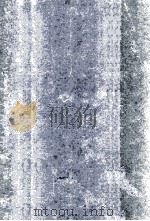
- Advances in Information Systems Science Volume 6
- 1976 Plenum Press
-
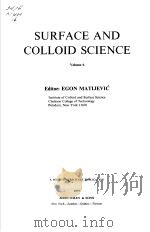
- SURFACE AND COLLOID SCIENCE VOLUME 6 (EGON MATIJEVIC)
- JOHN WILEY & SONS
-
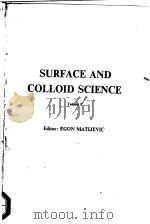
- SURFACE AND COLLOID SCIENCE VOLUME 8
- JOHN WILEY
-

- FUNDAMENTALS OF INTERFACE AND COLLOID SCIENCE Volume 1
- 1991 ACADEMIC [RESS LIMITED
-
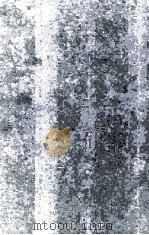
- Advances in Information Systems Science Volume 7
- 1978 Plenum Press
-

- SURFACE AND COLLOID SCIENCE VOLUME 12
- 1982 PLENUM PRESS
-

- COLLOID SCIENCE VOLUME 3
- 1979 THE CHEMICAL SOCIETY
-

- Surface and colloid science in computer technology
- 1987 Plenum Press
-
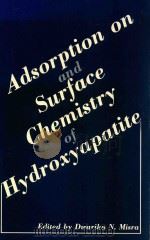
- Adsorption on and Surface Chemistry of Hydroxyapatite
- 1984 Springer
-
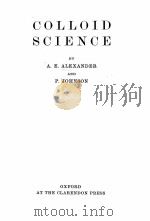
- COLLOID SCIENCE
- 1947 AT THE CLARENDON PRESS
-
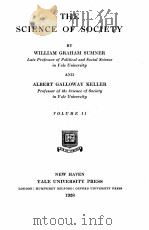
- THE SCIENCE OF SOCIETY VOLUME Ⅱ
- 1928 NEW YORK YALE UNIVERSITY PRESS
-

- BIOPOLYMERIC CONTROLLED RELEASE SYSTEMS VOLUME Ⅱ
- 1984 CRC PRESS
-
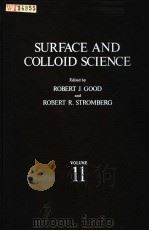
- SURFACE AND COLLOID SCIENCE VOLUME II
- 1979 PLENUM PRESS NEW YORK AND LONDON
-
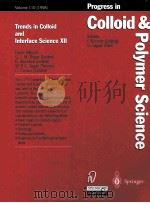
- TRENDS IN COLLOID AND INTERFACE SCIENCE XII VOLUME 110(1998)
- 1998 STEINKOPFF DARMSTADT AND SPRINGER
提示:百度云已更名为百度网盘(百度盘),天翼云盘、微盘下载地址……暂未提供。➥ PDF文字可复制化或转WORD
